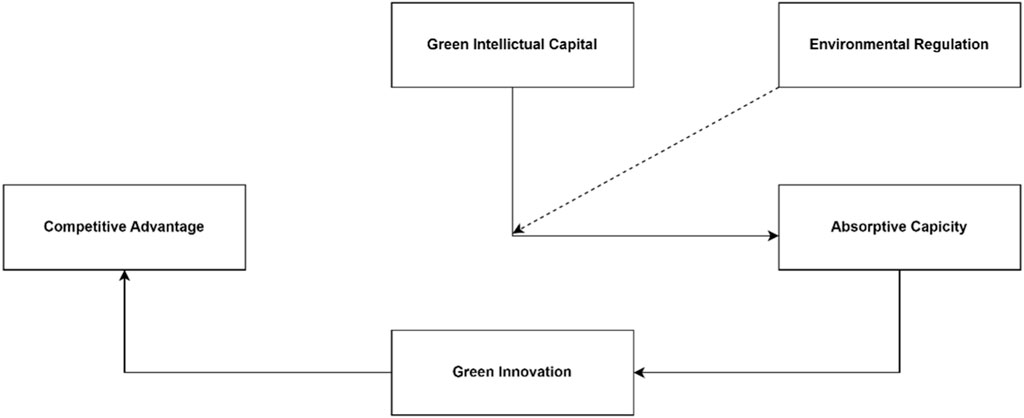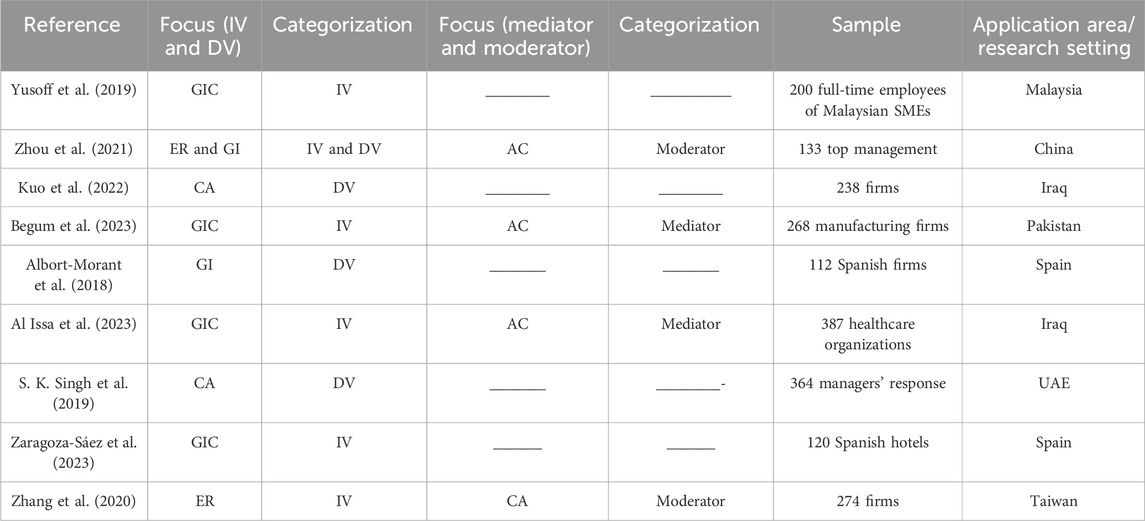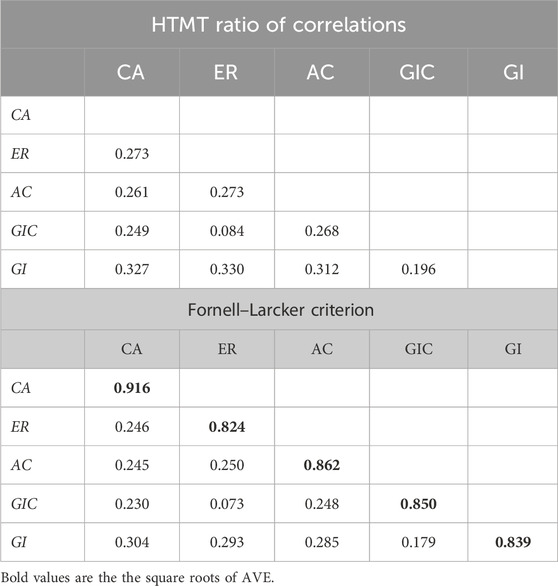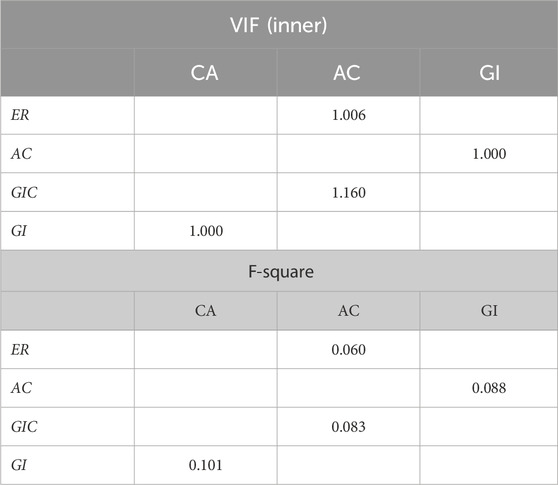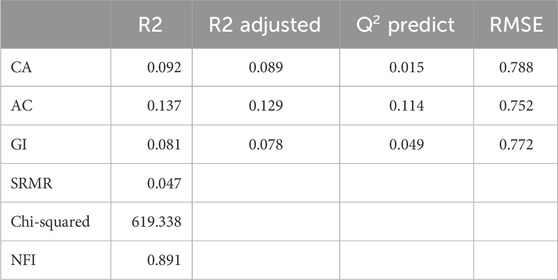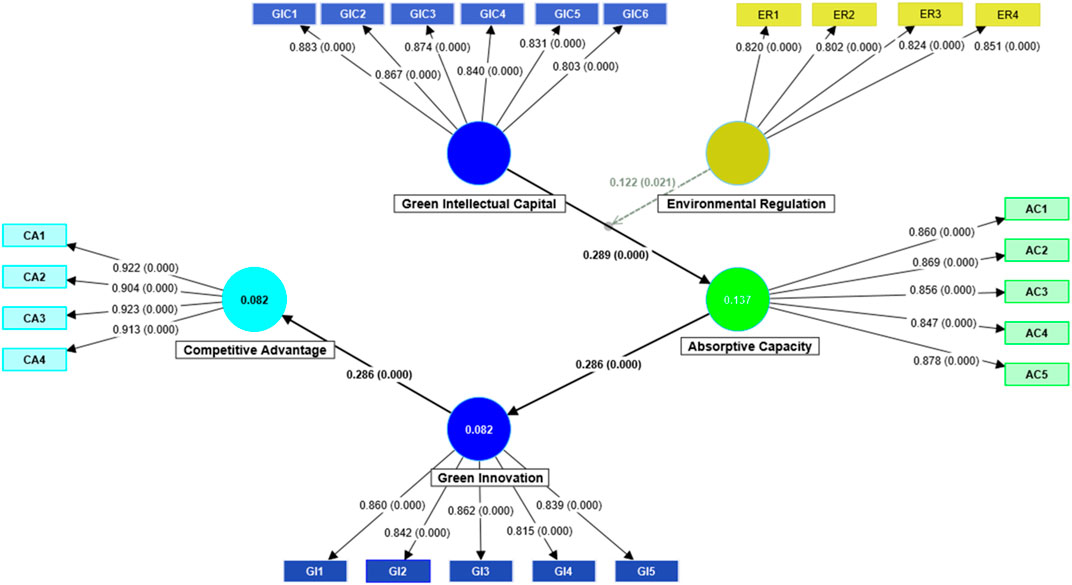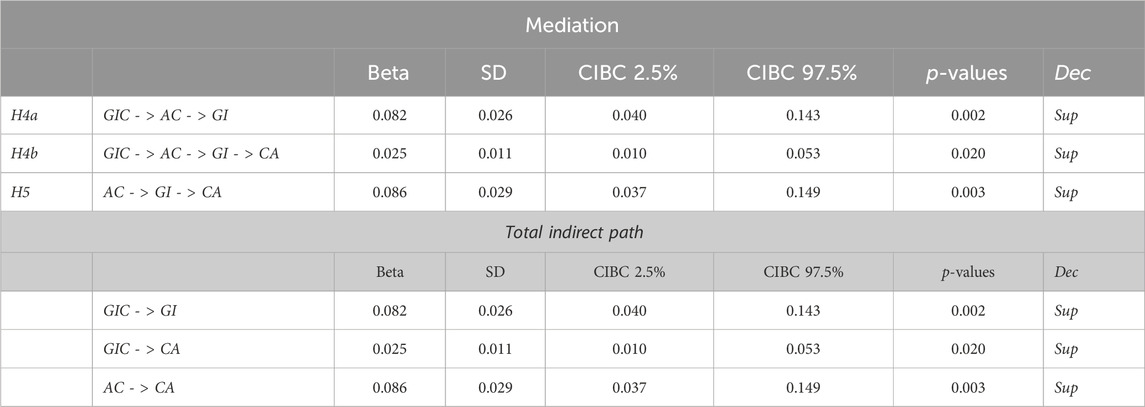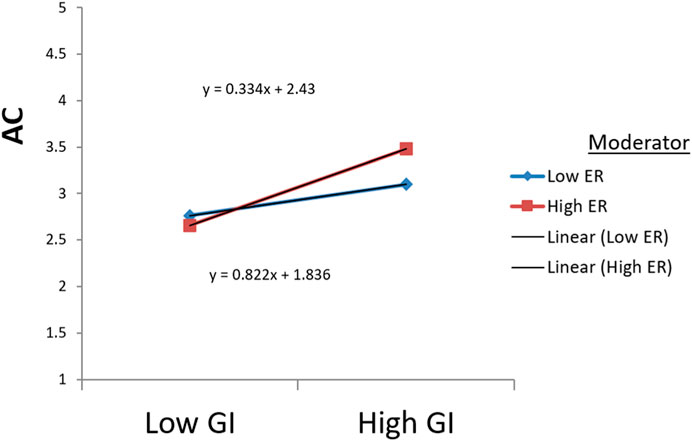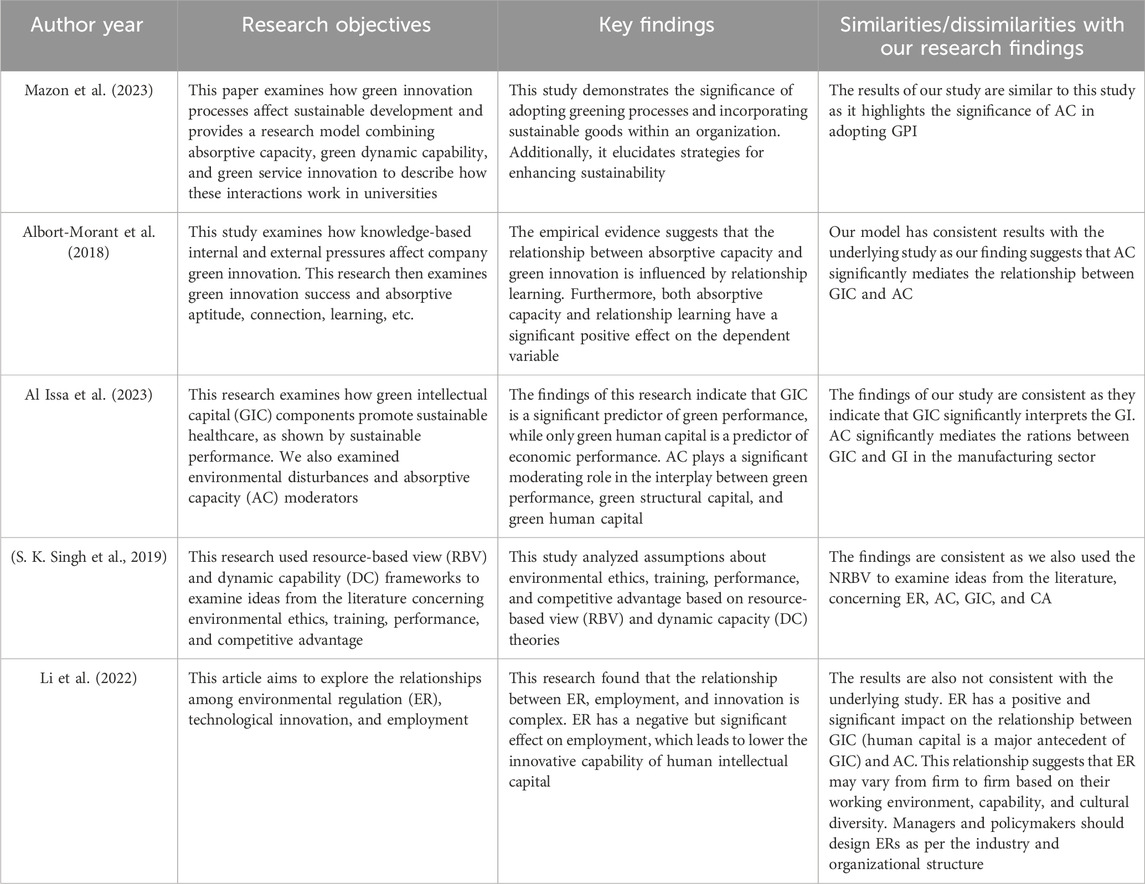- 1School of Management, Jiangsu University, Zhenjiang, Jiangsu, China
- 2Department of Business Administration, Sukkur IBA University, Sukkur, Pakistan
- 3Department of Management Sciences, SZABIST University, Hyderabad, Pakistan
- 4School of International Relations, Minhaj University, Lahore, Pakistan
- 5Doctoral School of Management and Business Administration, John Von Neumann University, Budapest, Hungary
- 6Business Management and Marketing Department, School of Business and Economics, Westminster International University in Tashkent, Tashkent, Uzbekistan
Within the evolving landscape of contemporary business, where sustainability and innovation intertwine, our study explores a strategic gap, presenting the rationale behind choosing green intellectual capital (GIC), absorptive capacity (AC), green innovation (GI), environmental regulations (ERs), and competitive advantage (CA) as main constructs. This model investigates the complex nature of the competitive landscape of SMEs within the vibrant manufacturing sector using the latest version of SmartPLS 4 for analyzing complex data. Drawing upon the theory of the natural resource-based view (NRBV), this study uncovers that GIC advances GI and AC, driving SMEs toward sustainable CA, particularly within the context of ER. These findings propose vital insights for SMEs looking to leverage their valuable resource, contributing to greening operations and reaching sustainable competitiveness while also contributing to theoretical developments in understanding resource-based perceptions on greening the manufacturing of SMEs. Findings reveal the significant impact of GIC on AC and GI and their subsequent impact on CA. Furthermore, ER uncovers the essential role in shaping the link between GIC and AC, thus enhancing SMEs’ capacity to achieve sustainable competitiveness. This study discloses how SMEs utilize GIC to identify ER and achieve CA and how the NRBV develops an understanding of SMEs utilizing their unique resource endowments to drive GI and achieve CA. This study examines the mediating role of AC and GI in this relationship.
1 Introduction
In an increasingly complex world, the ability to acquire and utilize skills, knowledge, expertise, and intangible assets within a company is essential, with a particular focus on environmental sustainability and ecological apprehensions. GIC based on employee knowledge serves as a vibrant ecosystem where the grouping and replacement of skills and knowledge become significant drivers of innovation and development (Asiaei et al., 2023). The contemporary business landscape emphasizes sustainability, where enterprises strive to balance economic objectives with environmental responsibility. The concept of GIC, which encompasses a reservoir of intangible assets within a company that focuses on environmental sustainability and ecological concerns, is essential. GIC encompasses not only intellectual resources but also expertise and innovations that contribute to the adoption and implementation of environmentally friendly practices and policies. It involves intellectual resources and competencies that add to the progress, adoption, and execution of environmentally friendly practices, policies, and novelties (Begum et al., 2023; Marco-Lajara et al., 2023; Wei et al., 2023). The concept of GI encompasses the implementation of environmentally friendly practices and the creation of innovative, resource-efficient goods and services. It has emerged as a significant criterion for assessing the sustainable competitive advantage of profit-oriented organizations (Al Halbusi et al., 2022; Chan et al., 2022; Tan et al., 2022). GIC gives companies a first-mover advantage that lets them charge more for green goods and services to improve their revenue and enter new markets (Xie et al., 2019).
The current research has underscored the correlation between AC and GI (Albort-Morant et al., 2018), AC and green project performance organization (Gerdoçi et al., 2023; Singh et al., 2023), AC and FP (Forés and Fernández-Yáñez, 2023; Nureen et al., 2023), GIC and GI (Marco-Lajara et al., 2023), and ER and GI (Al Halbusi et al., 2022). However, our study examines the association between GIC, GI, and CA in SMEs’ manufacturing sector through altering the role of government intervention in regulating environmental sustainability. This study highlights the mediating function of AC and the moderating influence of ER within manufacturing SMEs in enhancing both GI and CA. Furthermore, our investigation bridges these gaps through theoretical support by integration and investigating the role of NRBV in enhancing GI and CA to pursue environmental sustainability while enhancing their competitiveness. In this study, we consider the importance of the GIC, GI, and AC capabilities of SMEs in achieving sound knowledge of how SMEs implement this knowledge in pursuing environmental sustainability and competitiveness.
2 Literature review
2.1 Theoretical foundation of the NRBV
The concept of the NRBV highlights the strategic significance of organization-specific resources such as GIC and AC for achieving a competitive edge and remarkable innovation performance (Hart, 1995; Cabral and Dhar, 2019; Begum et al., 2023). The NRBV suggests that GPI and AC practices help gain GI and CA (Lin and Chen, 2017; Albort-Morant et al., 2018; Bhatia, 2021). This study is strongly built on the NRBV theory, a theoretical model that emphasizes the strategic role of organization-specific resources. Particularly, the NRBV focuses on the significant role of GIC and AC in achieving a CA and leading innovation performance (Shan et al., 2018). This study establishes the importance of the NRBV in understanding the role of GIC and AC in gaining CA and fostering sustainable innovation. Furthermore, our study seeks to extend the existing literature by conceptualizing the intricate relationships between GIC, AC, GI, and SMEs’ performance in adopting ER.
2.2 GIC, AC, and GI
The literature reveals that GIC has a significant, direct, and positive influence on AC (Mady et al., 2022; Al Issa et al., 2023; Begum et al., 2023), sustainable business (Yusoff et al., 2019), and GI performance (Tran et al., 2023). The concepts of GIC and AC are widely acknowledged as the primary drivers of organizational innovation (Marco-Lajara et al., 2023). This is because the abilities, experiences, and skills of individuals are essential in contributing to the overall organizational capacity for GI (Tran et al., 2023; Wei et al., 2023). The literature has shown that workers must have excellent environmental knowledge and abilities to establish ecologically responsible corporate operations and product innovations (Marco-Lajara et al., 2023). When a company understands the implications of AC and has a highly skilled GHC, employees are expected to contribute more actively to environmental preservation (Rehman, Kraus et al., 2021; S. K; Singh et al., 2020).
Firms focusing on AC and GI are deeply intertwined with GHC and other environmentally conscious organizational resources and contribute to the development of new environment-friendly products and processes (Jardon and Dasilva, 2017; Demartini and Beretta, 2020; Yusliza et al., 2020). Few studies suggested that specific elements of the GSC and databases play a crucial role in enhancing the effectiveness of the GHC and implementing AC, leading to an increased ability to develop and implement green performance (Salvi et al., 2020; Mirani et al., 2021; Naveed et al., 2023). Likewise, enterprises with a high level of GSC exhibit an enhanced capacity for organizational learning, consequently leading to their GI augmentation (Ahmed et al., 2022). As a result, companies that enhance their GSC will observe a significant enhancement in their innovation performance (Marco-Lajara et al., 2023). Firms with strong absorptive capabilities and customer engagement can effectively identify and address customer needs during the development of novel environment-friendly products and processes, achieving successful CA (Wimalachandra et al., 2014).
AC plays a crucial role in recognizing environmental pressures, defining effective strategies to address manufacturing waste challenges, and fostering innovative green performance (Song et al., 2020; Mady et al., 2022). Organizations with AC are expected to utilize environmental opportunities to gain a CA. GIC is an essential component of the company’s recognition and integration of environmental data obtained from external sources (Cassol et al., 2016; Begum et al., 2023). Previous studies showed that a firm’s intellectual capital facilitates its assimilation ability and enhances AC (Engelman et al., 2017; Mahmood and Mubarik, 2020). Firms with solid primary competency can expand their manufacturing capabilities and integrate various technologies (Srivastava, 2005).
H1:. There is a meaningful relationship between GIC and AC.
H2:. There is a meaningful relationship between AC and GI.
2.3 GI and CA
A competitive advantage is a position of superiority in the market that allows a company to surpass its competitors in performance (Coyne, 1986; C.-H; Wang, 2019). GI has a positive, significant, and direct impact on CA (Chang, 2011; Chen et al., 2006; Chen and Chang, 2013; Nanath and Pillai, 2017; C.-H; Wang, 2019). To achieve a competitive advantage, it is essential for the company to generate a positive value that is either equivalent to or surpasses that of its rivals (Shah et al., 2021; Tian et al., 2023). Acquiring new customers, advancing one’s market position, and achieving a competitive edge are all necessary steps in the process of elevating GI (Takalo and Tooranloo, 2021). In our empirical study, we found that there is a significant relationship between GI and CFA, as examined in several research studies (Alziady and Enayah, 2019; Junejo et al., 2022; Iqbal et al., 2023). GPSI, such as discovering new markets for environmentally responsible products, improving resource productivity and recycling, and improving environmental efficacy and service quality (Castellacci and Lie, 2017), are often cited in studies on corporate GI (Takalo and Tooranloo, 2021). Figure 2 highlights the combined use of current variables by different scholars in the literature.
H3:. There is a meaningful relationship between GI and CA.
2.4 Mediating effects of AC and GI
The fourth industrial revolution is linked to a simultaneous shift toward reliance on intangible resources rather than physical resources as a means to attain a competitive edge (Mahmood and Mubarik, 2020). Chen (2008) found that the positive impact of GIC on CA is notable. GIC functions as a pivotal source for identifying, assimilating, and disseminating information related to environmental management, thereby contributing to the enrichment of knowledge in this domain (Chen, 2008b). The adoption of GIC is essential for businesses striving to increase the visibility and market appeal of their environmentally friendly products and services (Chen and Lin, 2015; Mazon et al., 2023). AC denotes an organization’s capacity to identify, appreciate, assimilate, and apply novel external information pertaining to environmentally sustainable practices (Cohen and Levinthal, 1990; Albort-Morant et al., 2018). AC hinges on its capability to establish connections and seamlessly integrate new information with existing knowledge (Marco-Lajara et al., 2023). Zahra and George. (2002) found that potential absorptive capacity encompasses the procedures associated with acquiring and integrating knowledge. This facet equips organizations with the strategic flexibility and autonomy necessary to thrive within a dynamic and continually evolving context (Akhtar et al., 2023; Hongyun et al., 2023; Shodeinde et al., 2023). However, the organization might not necessarily apply the acquired knowledge (Leal-Rodríguez et al., 2014; Lee et al., 2021). GI presents multiple environmental advantages, including the reduction of environmental risks (Xie et al., 2022), decreased reliance on nonrenewable resources, and mitigation of pollution. SMEs that make strides in AC tend to benefit from enhanced GI (Pacheco et al., 2018). Consequently, the existing literature indicates a likelihood of AC acting as a moderator, amplifying the influences of GIC and conservation competencies on GI, and contributing to achieving CA.
AC demands a focus on control and consistency, contrasting with the flexibility, adaptability, and creativity that are integral to potential AC (Bjorvatn and Wald, 2018). On the other hand, AC involves the process of acquiring fresh insights and results through the integration of both existing and recently acquired information into an organization’s operations. Additionally, it encompasses the transformation and application of knowledge (Albort-Morant et al., 2018; Singh et al., 2023). The AC framework facilitates the assimilation and integration of external knowledge, enabling its conversion and subsequent utilization to attain desired outcomes (Zahra and George, 2002; Singh et al., 2023). Cohen and Levinthal (1990) introduced the concept of absorptive capacity (AC), laying the groundwork for understanding its role in knowledge acquisition and firm innovation. Building on prior research, Cohen and Levinthal (1990) explored the concept of AC, which paved the way for later studies examining its link to business innovation (Rauniar et al., 2023). AC plays a crucial role in a company’s ability to generate fresh perspectives on products and external knowledge. This equips organizations to innovate by creating new products, services, and ideas, ultimately securing a competitive edge and harnessing the advantages of knowledge acquisition (Albort-Morant et al., 2018; Cohen and Levinthal, 1990; Shodeinde et al., 2023; A. K; Singh, Jain et al., 2023). Investigating the relationship between AC and GI has unveiled that an organization’s efforts and investments in knowledge acquisition significantly influence the outcomes of green innovation (Leal-Rodríguez et al., 2013; Nisar et al., 2019). The concept of absorptive capacity (Danquah et al., 2018) has garnered substantial scholarly interest and is broadly acknowledged as a pivotal catalyst for engaging in innovative endeavors (Aboelmaged and Hashem, 2019). The potency of AC aids companies in enhancing GI and attaining a lasting competitive advantage by harnessing both external and internal expertise in green practices. Prior studies have explored the impact of organizational green capabilities on a firm’s competitive advantage through the NRBV (Hart, 1995). Khan et al. (2022) discovered that the adoption of GI within manufacturing organizations could result in substantial enhancements in environmental sustainability and financial performance, culminating in the achievement of CA.
H4a:. AC significantly mediates the relationship between GIC and GI.
H4b:. AC and GI significantly mediate the relationship between GIC and CA.
H5:. GI significantly mediates the relationship between AC and CA.
2.5 The moderating role of ER
ER functions as an external catalyst that facilitates the exchange of novel information and skills across various organizations. Consequently, this process creates avenues for pursuing environmentally conscious initiatives. Notably, ER exerts a substantial and favorable impact on GI, encompassing both products PRI and GPSI (Jaffe and Palmer, 1997; Javeed et al., 2023; Liang et al., 2023). Increasing levels of environmental concern and related challenges (De Medeiros et al., 2022) have required governments to enact more stringent policies (Jiang et al., 2018). Environmental regulations have imposed constraints on research regarding GI, and academic institutions hold divergent viewpoints on how these regulations affect corporate interests in green innovation. These regulations establish a formal framework that subjects corporations to substantial institutional pressure (Ling Guo et al., 2017). Stringent regulations can curtail capabilities, leading to reduced efficiency in GIC in alignment with AC and GI (Li et al., 2022). Environmental regulations often set benchmarks and goals for GI and environmental performance. These encompass targets such as emission reduction and improved resource efficiency (Singh et al., 2023). Figure 1 shows the conceptual framework and Table 1 shows the literature of variables (GIC, ER, GI, and CA).
H6:. ER significantly moderates the relationship between GIC and AC
3 Research methodology
3.1 Data collection and sample
Research data were collected from manufacturing SMEs operating in all provinces of Pakistan. Questionnaires were distributed online through email and WhatsApp, and two reminders were sent after every week. After an in-depth analysis and the feasibility of getting accurate and quick responses, manufacturing SMEs were considered for analysis. Only those SMEs were included in the data collection process that believe in current environmental effects, follow and implement green practices, and actively work on environmental improvement to adopt and implement pro-environmental policies. To ensure the right sample selection, SMEs that are really active in practicing environmental development were finalized as the sample. The exclusion of certain companies was based on their limited engagement with green initiatives and a lack of active involvement in environmental improvement efforts. This rigorous criterion was applied to ensure that the selected SMEs truly represented the context of interest and contributed to the objectives of our study.
CEOs, directors, or managers were considered to complete the surveys as they had better knowledge about valuable intellectual capital, current environmental policies, and green practices that have been followed and implemented by the SMEs in the last 7 years. A total of 920 questionnaires were distributed, and the response rate was 47.5% (437). After removing 98 incomplete responses based on missing and unfilled responses, the remaining 339 responses were retrieved and considered for further analysis. As per Hair et al. (2014), data size should be greater than 10 times the number of structural paths, leading to a particular parameter in the structural model, and the sample size used has met the criteria. To validate the questionnaire, academic and industrial experts analyzed the questionnaire before sending it directly to the respondents. A 5-point Likert scale was used to range the responses from 1 for “strongly disagree” to 5 for “strongly agree.” The industrial and demographic information is shown in Table 2. All adopted measures are mentioned in Table 3.
3.2 Reliability and validity
This study used PLS-SEM to analyze the data using SmartPLS latest version 4. A measurement model was used to establish validity and reliability. In Table 3, we have all the measures (factor loadings (FL), Cronbach alpha (CA), composite reliability (CR), average variance extracted (AVE), and variance inflation factor (inner VIF)) to check the reliability and validity of data. All values meet the threshold criteria (Henseler et al., 2015; Kock, 2017; Hair Jr et al., 2021) (FL > 0.704, CA > 0.70, CR > 0.70, AVE >0.50, and inner VIF <5). Notably, all factor loadings exceed the recommended threshold of 0.704, confirming the reliability of the measurement model. The alpha values meet the threshold of 0.70, establishing high reliability by implying that the items within each construct consistently measure the intended latent variable. The AVE exceeds the recommended threshold of 0.50, indicating a substantial proportion of the variance in the observed construct is attributed to the underlying variable. Hence, reliability and validity are established, and all the values are shown in Table 3. GIC 7 was excluded due to low factor loadings, indicating insufficient contribution to the measurement of green intellectual capital, and all other items were kept for analysis.
Furthermore, two criteria were used to address discriminant validity: the HTMT and Fornell–Larcker criteria. Table 4 highlights that both criteria meet the threshold value (Henseler et al., 2015). The HTMT values are <0.85, and the diagonal elements in the Fornell–Larcker criterion are higher than the correlations with other constructs. The highest and lowest HTMT values are 0.084 and 0.330, respectively, and the square root of AVE for AC is 0.862, which is higher in the entire row and column. Hence, discriminant validity is also established.
3.3 Common method bias
This paper observed data using the variance inflation factor (both inner and outer VIF values) to address multicollinearity issues. We used VIF values to ensure the methodological robustness of our study and address potential common method bias. The careful consideration of VIF values strengthens the validity of our findings by minimizing the impact of common method bias. Table 5 shows that all VIF values meet the threshold (VIF <5) (Kock, 2017) (ranging from 1 to 1.18 for inner VIF), indicating that the data are a good fit for the model. VIF values are effective in identifying multicollinearity issues, but they may not capture all nuances related to common method bias. The reliance on statistical measures alone may not fully account for all potential sources of bias in survey-based research. F2 or effect size is to identify the strength of the relationship in the endogenous variable explained by a specific exogenous construct that there are moderate, high, and satisfactory correlations as f2 ranges from 0.060 to 0.101.
4 Results
4.1 R-square and adjusted R-square
The values of R-squared (R2) and adjusted R-squared (R2 adjusted) provide information about how well the independent variables explain the variance in the dependent variable and estimate the model’s fitness. The explanatory power of a model can be quantified by calculating its R2 value. For the AC, the R2 value is 0.137, indicating that approximately 13.7% of the variance is explained by the exogenous variables over AC and the remaining 86.3% variation is unexplained in the model (see Table 6). To evaluate the predictive power of the model, researchers used the Q2 value technique (Shmueli et al., 2019). PLSPredict, SRMR, RMSE, chi-squared, and NFI values are used to predict the model’s goodness of fit as R2 does. Table 6 shows that the SRMR, chi-squared, and NFI values are 0.047, 619.338, and 0.891, respectively, suggesting that the model is a good fit. The value of SRMR suggests a good fit, indicating that the model’s predicted correlations closely align with the observed correlations. A better model fit is indicated by a lower SRMR value. The value of NFI closer to 1 suggests a more accurate representation of the observed data. Q2 helps determine how much an exogenous construct influences an endogenous construct. Q2 values of CA, AC, and GI are 0.015, 0.114, and 0.049, respectively, which suggests a significant predictive importance of the model. These values represent the proportion of variance in each endogenous construct that is predictable based on the exogenous constructs. All other values are shown in Table 6.
4.2 Direct path analysis
The direct path analysis examines the direct relationships between the independent and dependent variables. Figure 2 shows all hypotheses from H1 to H3 are direct, positive, and significant. H1 suggests that GIC is positively associated with AC (beta-value = 0.289 and p-value 0.000), confirming a significant relationship. Further results are shown in Table 7.
4.3 Specific indirect path analysis/mediation
The specific indirect path analysis examined the mediating effect of constructs, and the total indirect path analysis suggests partial and full mediations. All mediating paths (H4a to H5) are positive, indirect, and significant. H4b shows that the mediating effect of GIC on CA through AC and GI is weak, positive, and significant (beta-value: 0.025; p-value: 0.000). All indirect paths are significant and partially mediated. Further results are shown in Table 8.
4.4 Moderation
In addition, we observed the moderating role of ER between GIC and AC. Table 9 highlights that the moderating path is found positive and significant with a beta-value of 0.122 and p-value of 0.021, suggesting the acceptance of hypothesis H6. Table 9 and Figure 3 show that ER strengthens the positive relationship between GIC and AC. The moderation result suggests that, in the context of Pakistani SMEs, compliance with ER strengthens the ability of an organization to absorb and utilize GIC effectively. SMEs should consider aligning strategies with ER to not only meet compliance standards but also enhance their AC, thereby fostering sustainable CA.
5 Discussion and findings
Findings reveal that GIC and AC are vital in enhancing GI and maintaining SMEs’ competitive advantage. It has been observed that AC can enhance SMEs’ green innovative performance through ER. The NRBV is effective for enhancing green performance and competitiveness when integrated with GIC and AC. Unlocking SMEs’ potential requires continued government support, clear guidelines, incentives, addressing policy obstacles, and advice for a smooth transition toward a sustainable future (Kumar et al., 2022; Kumar et al., 2023). Furthermore, we have elaborated the discussion section in more detail in Table 10.
6 Conclusion
This study investigates vital interrelationships among constructs within the context of Pakistani SMEs. The model, grounded in the NRBV, examines the nexus involving GIC, AC, GI, ER, and CA. The study is significant in leveraging SMEs’ competitive edge via GIC, facilitated by AC and ER. Notably, GIC has a direct and positive impact on AC and GI, affirming its significant role in shaping SMEs’ innovative capacities. Mediation analyses underscore AC and GI’s role in transmitting GIC’s effects onto CA. ER’s moderation role and its impact on GIC and AC emphasize the importance of aligning with external regulations. This collective insight underscores SMEs’ need for a comprehensive sustainable innovation approach. The findings highlight that fostering GIC support CA through AC and GI strengthens the competitive advantage.
6.1 Limitation and future recommendations
Limitations serve as potential avenues for future research, and this paper has underscored certain limitations. Conducting research in a specific region and organization restricts the data scope, limiting the generalizability of the results. The specific regional and organizational focus of our study may limit the applicability of results to other regions or industries. Furthermore, scholars often overlook Pakistan’s distinct contextual factors, including regulations and market conditions. These factors could potentially exert varying influences on the connections between GIC, AC, GI, and firm competitiveness in the manufacturing sector, and the same study may have different findings in other countries, which can also be used for comparative analysis of future studies. To enhance the robustness of our findings and contribute to a more comprehensive understanding, future research should involve comparative analyses with studies conducted in other countries and industries. By systematically exploring the commonalities and disparities in the connections between GIC, AC, GI, and firm competitiveness, researchers can better discern the impact of contextual variables. This comparative analysis aids in comprehending how contextual variables affect the connections between GIC, AC, and performance outcomes across diverse contexts. Exploring the potential moderating influence of ER on linkages between GIC and AC would involve understanding Pakistan’s unique regulatory constraints and opportunities, and the same effect may vary depending on different regions and types of industries. Integrating these future recommendations could enhance the validity, relevance, and practical application of research outcomes.
6.2 Theoretical implications
Using the NRBV, this study investigated the relationships between GIC and AC over GI and of GI over CA.
Within the context of sustainability and green practices, the findings of this study enrich the theoretical model proposed by the NRBV theory. Particularly, it highlights how GIC serves as a distinctive resource that, when leveraged effectively through AC and GI, provides SMEs with a sustainable CA. This extension of the NRBV to the green realm advances the understanding of how green resources contribute to enhancing environmental performance, aligning with the broader goals of sustainable development. SMEs in developing nations can unlock circular growth by embracing not just digital innovation but also the circular economy, driven by entrepreneurship direction and market direction toward sustainability (Dwivedi et al., 2023). Achieving sustainable growth in manufacturing requires prioritizing greenhouse gas performance and encouraging low-carbon products to ensure a green and sustainable future for manufacturing SMEs (Dwivedi et al., 2023).
Furthermore, our model contributes to the existing theory of NRBV by extending its application to the context of sustainability and green practices (Hart, 1995; Campbell, 2007). Furthermore, the positive moderation effect of ER on the relationship between GIC and AC underscores the importance of supportive ER. Policymakers should consider these findings to design and implement regulations that not only encourage but also strengthen the relationship between GIC and AC in the context of SMEs in Pakistan. This can, in turn, contribute to the overall sustainable development goals of the country. This model goes beyond theoretical exploration by offering empirical validation of the main arguments proposed by the NRBV. Particularly, the findings of this study substantiate the NRBV theory claim that AC and GI are integral and vital green resources that significantly boost the performance of firms. The empirical results underscore the CA gained by SMEs through the effective utilization of AC and GI, aligning with the fundamental ideas of the NRBV. This confirmation further emphasizes the relevance and applicability of the NRBV theory in the context of green practices within the SME’s manufacturing sector.
Data availability statement
The raw data supporting the conclusion of this article will be made available by the authors, without undue reservation.
Ethics statement
Ethical review and approval was not required for the study on human participants in accordance with the local legislation and institutional requirements. Written informed consent (from the patients/participants or patients’/participants’ legal guardian/next of kin) was not required to participate in this study in accordance with the national legislation and institutional requirements.
Author contributions
JS: conceptualization, data curation, formal analysis, investigation, methodology, project administration, software, supervision, validation, visualization, writing–original draft, and writing–review and editing. TH: conceptualization, methodology, supervision, validation, and writing–review and editing. IJ: conceptualization, formal analysis, methodology, and writing–review and editing. SA: data curation, investigation, methodology, validation, and writing–original draft. FE: data curation, formal analysis, investigation, software, validation, and writing–review and editing. AD: Methodology, funding acquisition, data curation, resources, validation, and writing–review and editing. MH: Conceptualization, methodology, data curation, formal analysis, investigation, validation, software, and writing–review and editing.
Funding
The author(s) declare that no financial support was received for the research, authorship, and/or publication of this article.
Acknowledgments
The authors acknowledge the valuable assistance of Dr. Nabeel Nisar and Fodor Zita Júlia in refining the manuscript. Their critical revisions and suggestions regarding refining arguments, manuscript organization, and language improved the clarity and accuracy of the final work. The authors recognize their expertise and express their appreciation for their contribution to the quality of this research. This research also received financial support from the National Social Science Fund of China (grant number: 21BGL069).
Conflict of interest
The authors declare that the research was conducted in the absence of any commercial or financial relationships that could be construed as a potential conflict of interest.
Publisher’s note
All claims expressed in this article are solely those of the authors and do not necessarily represent those of their affiliated organizations, or those of the publisher, the editors, and the reviewers. Any product that may be evaluated in this article, or claim that may be made by its manufacturer, is not guaranteed or endorsed by the publisher.
References
Aboelmaged, M., and Hashem, G. (2019). Absorptive capacity and green innovation adoption in SMEs: the mediating effects of sustainable organisational capabilities. J. Clean. Prod. 220, 853–863. doi:10.1016/j.jclepro.2019.02.150
Ahmed, A., Bhatti, S. H., Gölgeci, I., and Arslan, A. (2022). Digital platform capability and organizational agility of emerging market manufacturing SMEs: the mediating role of intellectual capital and the moderating role of environmental dynamism. Technol. Forecast. Soc. Change 177, 121513. doi:10.1016/j.techfore.2022.121513
Akhtar, S., Li, C., Sohu, J. M., Rasool, Y., Hassan, M. I. U., and Bilal, M. (2023). Unlocking green innovation and environmental performance: the mediated moderation of green absorptive capacity and green innovation climate. Environ. Sci. Pollut. Res. 58 (30), 4547–4562. doi:10.1007/s11356-023-31403-w
Albort-Morant, G., Leal-Rodríguez, A. L., and De Marchi, V. (2018). Absorptive capacity and relationship learning mechanisms as complementary drivers of green innovation performance. J. Knowl. Manag. 22, 432–452. doi:10.1108/jkm-07-2017-0310
Al Halbusi, H., Klobas, J. E., and Ramayah, T. (2022). Green core competence and firm performance in a post-conflict country. Iraq. Bus. Strategy Environ. 32(3), doi:10.1002/bse.3265
Al Issa, H.-E., Abdullatif, T. N., Ntayi, J., and Abdelsalam, M. K. (2023). Green intellectual capital for sustainable healthcare: evidence from Iraq. J. Intellect. Cap. 24 (4), 929–947. doi:10.1108/jic-02-2022-0046
Alziady, A. A. D. J., and Enayah, S. H. (2019). Studying the effect of institutional pressures on the intentions to continue green information technology usage. Asian J. Sustain. Soc. Responsib. 4 (1), 4–20. doi:10.1186/s41180-018-0023-1
Asiaei, K., O’Connor, N. G., Barani, O., and Joshi, M. (2023). Green intellectual capital and ambidextrous green innovation: the impact on environmental performance. Bus. Strategy Environ. 32 (1), 369–386. doi:10.1002/BSE.3136
Begum, S., Ashfaq, M., Asiaei, K., and Shahzad, K. (2023). Green intellectual capital and green business strategy: the role of green absorptive capacity. Bus. Strategy Environ. 32 (7), 4907–4923. doi:10.1002/bse.3399
Bhatia, M. S. (2021). Green process innovation and operational performance: the role of proactive environment strategy, technological capabilities, and organizational learning. Bus. Strategy Environ. 30 (7), 2845–2857. doi:10.1002/bse.2775
Bjorvatn, T., and Wald, A. (2018). Project complexity and team-level absorptive capacity as drivers of project management performance. Int. J. Proj. Manag. 36 (6), 876–888. doi:10.1016/j.ijproman.2018.05.003
Cabral, C., and Dhar, R. L. (2019). Green competencies: construct development and measurement validation. J. Clean. Prod. 235, 887–900. doi:10.1016/j.jclepro.2019.07.014
Campbell, J. L. (2007). Why would corporations behave in socially responsible ways? An institutional theory of corporate social responsibility. Acad. Manag. Rev. 32 (3), 946–967. doi:10.5465/amr.2007.25275684
Cassol, A., Gonçalo, C. R., and Ruas, R. L. (2016). Redefining the relationship between intellectual capital and innovation: the mediating role of absorptive capacity. BAR-Brazilian Adm. Rev. 13. doi:10.1590/1807-7692bar2016150067
Castellacci, F., and Lie, C. M. (2017). A taxonomy of green innovators: empirical evidence from South Korea. J. Clean. Prod. 143, 1036–1047. doi:10.1016/j.jclepro.2016.12.016
Chan, R. Y., Lai, J. W., and Kim, N. (2022). Strategic motives and performance implications of proactive versus reactive environmental strategies in corporate sustainable development. Bus. Strategy Environ. 31 (5), 2127–2142. doi:10.1002/bse.3011
Chang, C.-H. (2011). The influence of corporate environmental ethics on competitive advantage: the mediation role of green innovation. J. Bus. Ethics 104, 361–370. doi:10.1007/s10551-011-0914-x
Chen, Y.-S. (2008). The positive effect of green intellectual capital on competitive advantages of firms. J. Bus. Ethics 77, 271–286. doi:10.1007/s10551-006-9349-1
Chen, Y.-S., and Chang, K.-C. (2013). The nonlinear effect of green innovation on the corporate competitive advantage. Qual. Quantity 47 (1), 271–286. doi:10.1007/s11135-011-9518-x
Chen, Y.-S., Lai, S.-B., and Wen, C.-T. (2006). The influence of green innovation performance on corporate advantage in taiwan. J. Bus. Ethics 67 (4), 331–339. doi:10.1007/s10551-006-9025-5
Chen, Y.-S., and Lin, Y.-H. (2015). Improvement of green human capital, green absorptive capacity and green dynamic capacities to achieve green service innovation: an analysis of structural equation modeling (SEM). Int. Conf. Energy Syst. Technol. 7(11).
Cohen, W. M., and Levinthal, D. A. (1990). Absorptive capacity: a new perspective on learning and innovation. Adm. Sci. Q. 35, 128–152. doi:10.2307/2393553
Coyne, K. P. (1986). Sustainable competitive advantage—what it is, what it isn’t. Bus. Horizons 29 (1), 54–61. doi:10.1016/0007-6813(86)90087-x
Danquah, M., Ouattara, B., and Quartey, P. (2018). Technology transfer and national efficiency: does absorptive capacity matter? Afr. Dev. Rev. 30 (2), 162–174. doi:10.1111/1467-8268.12321
Demartini, M. C., and Beretta, V. (2020). Intellectual capital and SMEs’ performance: a structured literature review. J. Small Bus. Manag. 58 (2), 288–332. doi:10.1080/00472778.2019.1659680
De Medeiros, J. F., Garlet, T. B., Ribeiro, J. L. D., and Cortimiglia, M. N. (2022). Success factors for environmentally sustainable product innovation: an updated review. J. Clean. Prod. 345, 131039. doi:10.1016/j.jclepro.2022.131039
Dwivedi, A., Sassanelli, C., Agrawal, D., Gonzalez, E. S., and D’Adamo, I. (2023a). Technological innovation toward sustainability in manufacturing organizations: a circular economy perspective. Sustain. Chem. Pharm. 35, 101211. doi:10.1016/j.scp.2023.101211
Dwivedi, A., Sassanelli, C., Agrawal, D., Moktadir, Md. A., and D’Adamo, I. (2023b). Drivers to mitigate climate change in context of manufacturing industry: an emerging economy study. Bus. Strategy Environ. 32 (7), 4467–4484. doi:10.1002/bse.3376
Engelman, R. M., Fracasso, E. M., Schmidt, S., and Zen, A. C. (2017). Intellectual capital, absorptive capacity and product innovation. Manag. Decis. 55 (3), 474–490. doi:10.1108/md-05-2016-0315
Forés, B., and Fernández-Yáñez, J. M. (2023). Sustainability performance in firms located in a science and technology park: the influence of knowledge sources and absorptive capacity. J. Knowl. Manag. 27 (11), 112–135. doi:10.1108/jkm-11-2022-0883
Gerdoçi, B., Busho, N., Lena, D., and Cucculelli, M. (2023). Disentangling the relationship between business model, absorptive capacity, differentiation strategy and performance. Evidence from a transition economy. Eur. J. Innovation Manag. 26 (7), 385–414. doi:10.1108/ejim-10-2022-0596
Gu, S. (2022). Green innovation; a way to enhance economic performance of Chinese hotels. Int. J. Innovation Sci. 15 (3), 406–426. doi:10.1108/IJIS-07-2021-0128
Hair, F., Sarstedt, M., Hopkins, L., and Kuppelwieser, V. (2014). Partial least squares structural equation modeling (PLS-SEM): an emerging tool in business research. Eur. Bus. Rev. 26 (2), 106–121. doi:10.1108/EBR-10-2013-0128
Hair, J. F., Hult, G. T. M., Ringle, C. M., and Sarstedt, M. (2021). A primer on partial least squares structural equation modeling (PLS-SEM). Thousand Oak, CA, USA, Sage publications.
Hart, S. L. (1995). A natural-resource-based view of the firm. Acad. Manag. Rev. 20 (4), 986–1014. doi:10.5465/amr.1995.9512280033
Henseler, J., Ringle, C. M., and Sarstedt, M. (2015a). A new criterion for assessing discriminant validity in variance-based structural equation modeling. J. Acad. Mark. Sci. 43, 115–135. doi:10.1007/s11747-014-0403-8
Henseler, J., Ringle, C. M., and Sarstedt, M. (2015b). A new criterion for assessing discriminant validity in variance-based structural equation modeling. J. Acad. Mark. Sci. 43 (1), 115–135. doi:10.1007/s11747-014-0403-8
Hongyun, T., Sohu, J. M., Khan, A. U., Junejo, I., Shaikh, S. N., Akhtar, S., et al. (2023). Navigating the digital landscape: examining the interdependencies of digital transformation and big data in driving SMEs’ innovation performance. Kybernetes 53 (1), 1–29. doi:10.1108/K-07-2023-1183
Iqbal, S., Akhtar, S., Anwar, F., Kayani, A. J., Sohu, J. M., and Khan, A. S. (2023). Linking green innovation performance and green innovative human resource practices in SMEs; a moderation and mediation analysis using PLS-SEM. Curr. Psychol. 42 (13), 11250–11267. doi:10.1007/s12144-021-02403-1
Jaffe, A. B., and Palmer, K. (1997). Environmental regulation and innovation: a panel data study. Rev. Econ. Statistics 79 (4), 610–619. doi:10.1162/003465397557196
Jardon, C. M., and Dasilva, A. (2017). Intellectual capital and environmental concern in subsistence small businesses. Manag. Environ. Qual. Int. J. 28 (2), 214–230. doi:10.1108/meq-05-2015-0085
Javeed, S. A., Teh, B. H., Ong, T. S., Lan, N. T. P., Muthaiyah, S., and Latief, R. (2023). The connection between absorptive capacity and green innovation: the function of board capital and environmental regulation. Int. J. Environ. Res. Public Health 20 (4), 3119. doi:10.3390/ijerph20043119
Jiang, W., Chai, H., Shao, J., and Feng, T. (2018). Green entrepreneurial orientation for enhancing firm performance: a dynamic capability perspective. J. Clean. Prod. 198, 1311–1323. doi:10.1016/j.jclepro.2018.07.104
Junejo, I., Sohu, J. M., Aijaz, A., Ghumro, T. H., Shaikh, S. H., and Seelro, A. D. (2022). The mediating role of brand attitude for purchase intention: empirical evidence from fast food industry in Pakistan. ETIKONOMI 21 (1), 103–112. doi:10.15408/etk.v21i1.22302
Khan, R. U., Arif, H., Sahar, N. E., Ali, A., and Abbasi, M. A. (2022). The role of financial resources in SMEs’ financial and environmental performance; the mediating role of green innovation. Green Finance 4 (1), 36–53. doi:10.3934/gf.2022002
Kock, N. (2017). “Common method bias: a full collinearity assessment method for PLS-SEM,” in Partial least squares path modeling: basic concepts, methodological issues and applications. Editors H. Latan, and R. Noonan (Springer International Publishing), Salmon Tower, NY, USA, 245–257. doi:10.1007/978-3-319-64069-3_11
Kumar, B., Kumar, L., Kumar, A., Kumari, R., Tagar, U., and Sassanelli, C. (2023). Green finance in circular economy: a literature review. Environ. Dev. Sustain., 1–41. doi:10.1007/s10668-023-03361-3
Kumar, L., Nadeem, F., Sloan, M., Restle-Steinert, J., Deitch, M. J., Ali Naqvi, S., et al. (2022). Fostering green finance for sustainable development: a focus on textile and leather small medium enterprises in Pakistan. Sustainability 14 (19), 11908. doi:10.3390/su141911908
Kuo, F.-I., Fang, W.-T., and LePage, B. A. (2022). Proactive environmental strategies in the hotel industry: eco-innovation, green competitive advantage, and green core competence. J. Sustain. Tour. 30 (6), 1240–1261. doi:10.1080/09669582.2021.1931254
Leal-Rodríguez, A. L., Roldán, J. L., Ariza-Montes, J. A., and Leal-Millán, A. (2014). From potential absorptive capacity to innovation outcomes in project teams: the conditional mediating role of the realized absorptive capacity in a relational learning context. Int. J. Proj. Manag. 32 (6), 894–907. doi:10.1016/j.ijproman.2014.01.005
Leal-Rodríguez, A. L., Roldán, J. L., Leal, A. G., and Ortega-Gutiérrez, J. (2013). Knowledge management, relational learning, and the effectiveness of innovation outcomes. Serv. Industries J. 33 (13–14), 1294–1311. doi:10.1080/02642069.2013.815735
Lee, J.-C., Chou, I.-C., and Chen, C.-Y. (2021). The effect of process tailoring on software project performance: the role of team absorptive capacity and its knowledge-based enablers. Inf. Syst. J. 31 (1), 120–147. doi:10.1111/isj.12303
Li, C., Hwang, Y., and Yu, C. (2022). Research on the relationship between environmental regulation, technological innovation and employment: focused on China. J. Int. Logist. Trade 21, 2–17. ahead-of-print. doi:10.1108/jilt-09-2022-0050
Liang, P., Xie, S., Qi, F., Huang, Y., and Wu, X. (2023). Environmental regulation and green technology innovation under the carbon neutrality goal: dual regulation of human capital and industrial structure. Sustain. 2023, 15 (3), 2001. doi:10.3390/SU15032001
Lin, Y.-H., and Chen, Y.-S. (2017). Determinants of green competitive advantage: the roles of green knowledge sharing, green dynamic capabilities, and green service innovation. Qual. Quantity 51, 1663–1685. doi:10.1007/s11135-016-0358-6
ling Guo, L., Qu, Y., and Tseng, M.-L. (2017). The interaction effects of environmental regulation and technological innovation on regional green growth performance. J. Clean. Prod. 162, 894–902. doi:10.1016/j.jclepro.2017.05.210
Mady, K., Abdul Halim, M. A. S., Omar, K., Abdelkareem, R. S., and Battour, M. (2022). Institutional pressure and eco-innovation: the mediating role of green absorptive capacity and strategically environmental orientation among manufacturing SMEs in Egypt. Cogent Bus. Manag. 9 (1), 2064259. doi:10.1080/23311975.2022.2064259
Mahmood, T., and Mubarik, M. S. (2020). Balancing innovation and exploitation in the fourth industrial revolution: role of intellectual capital and technology absorptive capacity. Technol. Forecast. Soc. Change 160, 120248. doi:10.1016/j.techfore.2020.120248
Marco-Lajara, B., Zaragoza-Sáez, P. C., Martínez-Falcó, J., and Sánchez-García, E. (2023). Does green intellectual capital affect green innovation performance? Evidence from the Spanish wine industry. Br. Food J. 125 (4), 1469–1487. doi:10.1108/bfj-03-2022-0298
Mazon, G., Soares, T. C., Birch, R. S., Schneider, J., and Andrade Guerra, J. B. S. O. D. A. (2023). Green absorptive capacity, green dynamic capabilities and green service innovation: a study in Brazilian universities. Int. J. Sustain. High. Educ. 24 (4), 859–876. doi:10.1108/ijshe-10-2021-0454
Mirani, M. A., Junejo, I., Sohu, J. M., Naveed, H. M., and Shabir, A. (2021). The mediating role of information flow and factors for supplier selection. TEM J. 10 (1), 446–450. doi:10.18421/TEM101-56
Nanath, K., and Pillai, R. R. (2017). The influence of green IS practices on competitive advantage: mediation role of green innovation performance. Inf. Syst. Manag. 34 (1), 3–19. doi:10.1080/10580530.2017.1254436
Naveed, H. M., HongXing, Y., Memon, B. A., Ali, S., Alhussam, M. I., and Sohu, J. M. (2023). Artificial neural network (ANN)-based estimation of the influence of COVID-19 pandemic on dynamic and emerging financial markets. Technol. Forecast. Soc. Change 190, 122470. doi:10.1016/j.techfore.2023.122470
Nisar, T. M., Prabhakar, G., and Strakova, L. (2019). Social media information benefits, knowledge management and smart organizations. J. Bus. Res. 94, 264–272. doi:10.1016/j.jbusres.2018.05.005
Nureen, N., Liu, D., Ahmad, B., and Irfan, M. (2023). Relating green information acquisition, absorptive capacity, institutional pressure, and firm performance: an environmentally sustainable perspective. Environ. Sci. Pollut. Res. 30 (16), 46779–46794. doi:10.1007/s11356-023-25457-z
Pacheco, L. M., Alves, M. F. R., and Liboni, L. B. (2018). Green absorptive capacity: a mediation-moderation model of knowledge for innovation. Bus. Strategy Environ. 27 (8), 1502–1513. doi:10.1002/bse.2208
Rauniar, R., Rawski, G., Cao, Q. R., and Shah, S. (2023). Mediating effect of industry dynamics, absorptive capacity and resource commitment in new digital technology adoption and effective implementation processes. J. Enterp. Inf. Manag. doi:10.1108/jeim-06-2022-0190
Rehman, S. U., Bresciani, S., Ashfaq, K., and Alam, G. M. (2021a). Intellectual capital, knowledge management and competitive advantage: a resource orchestration perspective. J. Knowl. Manag. 26 (7), 1705–1731. doi:10.1108/JKM-06-2021-0453
Rehman, S. U., Kraus, S., Shah, S. A., Khanin, D., and Mahto, R. V. (2021b). Analyzing the relationship between green innovation and environmental performance in large manufacturing firms. Technol. Forecast. Soc. Change 163, 120481. doi:10.1016/j.techfore.2020.120481
Salvi, A., Vitolla, F., Giakoumelou, A., Raimo, N., and Rubino, M. (2020). Intellectual capital disclosure in integrated reports: the effect on firm value. Technol. Forecast. Soc. Change 160, 120228. doi:10.1016/j.techfore.2020.120228
Shah, S. M. M., Sohu, J. M., Dakhan, S. A., Ali, R. S., Junejo, I., and Chouhan, I. M. (2021). The reinvesting impact of promotional activity and store atmosphere on impulse buying behavior: the mediating role of payment facility. TEM J. 10 (1), 221–225. doi:10.18421/TEM101-28
Shan, S., Luo, Y., Zhou, Y., and Wei, Y. (2018). Big data analysis adaptation and enterprises’ competitive advantages: the perspective of dynamic capability and resource-based theories. , 31(4), 406–420. doi:10.1080/09537325.2018.1516866
Shodeinde, A. D., Nmadu, T. M., Olutuase, S. O., and Ijepe, E. A. (2023). Absorptive capabilities as determinants of economic sustainability of small and medium-scale enterprises. Bus. Perspect. Rev. 5 (1), 31–45. doi:10.38157/bpr.v5i1.537
Singh, A. K., Jain, N. K., Sharma, M. G., and Nigam, S. (2023a). Reconceptualization of absorptive capacity as potential and realized absorptive capacity for project-based organizations. Int. J. Proj. Manag. 41 (2), 102449. doi:10.1016/j.ijproman.2023.102449
Singh, A. K., Raza, S. A., Nakonieczny, J., and Shahzad, U. (2023b). Role of financial inclusion, green innovation, and energy efficiency for environmental performance? Evidence from developed and emerging economies in the lens of sustainable development. Struct. Change Econ. Dyn. 64, 213–224. doi:10.1016/j.strueco.2022.12.008
Singh, S. K., Chen, J., Del Giudice, M., and El-Kassar, A.-N. (2019). Environmental ethics, environmental performance, and competitive advantage: role of environmental training. Technol. Forecast. Soc. Change 146, 203–211. doi:10.1016/j.techfore.2019.05.032
Singh, S. K., Del Giudice, M., Chierici, R., and Graziano, D. (2020). Green innovation and environmental performance: the role of green transformational leadership and green human resource management. Technol. Forecast. Soc. Change 150, 119762. doi:10.1016/j.techfore.2019.119762
Song, M., Yang, M. X., Zeng, K. J., and Feng, W. (2020). Green knowledge sharing, stakeholder pressure, absorptive capacity, and green innovation: evidence from Chinese manufacturing firms. Bus. Strategy Environ. 29 (3), 1517–1531. doi:10.1002/bse.2450
Srivastava, S. C. (2005). Managing core competence of the organization. Vikalpa 30 (4), 49–64. doi:10.1177/0256090920050405
Takalo, S. K., Tooranloo, H. S., and Shahabaldini parizi, Z. (2021). Green innovation: a systematic literature review. J. Clean. Prod. 279, 122474. doi:10.1016/j.jclepro.2020.122474
Tan, K., Siddik, A. B., Sobhani, F. A., Hamayun, M., and Masukujjaman, M. (2022). Do environmental strategy and awareness improve firms’ environmental and financial performance? The role of competitive advantage. Sustainability 14 (17), 10600. doi:10.3390/su141710600
Tian, B., Fu, J., Li, C., and Wang, Z. (2023). Determinants of competitive advantage: the roles of innovation orientation, fuzzy front end, and internal competition. R&D Management.
Tran, T. D., Huan, D. M., Phan, T. T. H., and Do, H. L. (2023). The impact of green intellectual capital on green innovation in Vietnamese textile and garment enterprises: mediate role of environmental knowledge and moderating impact of green social behavior and learning outcomes. Environ. Sci. Pollut. Res. 30 (30), 74952–74965. doi:10.1007/s11356-023-27523-y
Wang, C.-H. (2019). How organizational green culture influences green performance and competitive advantage: the mediating role of green innovation. J. Manuf. Technol. Manag. 30 (4), 666–683. doi:10.1108/JMTM-09-2018-0314
Wang, C. H., and Juo, W.-J. (2021). An environmental policy of green intellectual capital: green innovation strategy for performance sustainability. Bus. Strategy Environ. 30 (7), 3241–3254. doi:10.1002/bse.2800
Wei, F., Abbas, J., Alarifi, G., Zhang, Z., Adam, N. A., and de Queiroz, M. J. (2023). Role of green intellectual capital and top management commitment in organizational environmental performance and reputation: moderating role of pro-environmental behavior. J. Clean. Prod. 405, 136847. doi:10.1016/j.jclepro.2023.136847
Wimalachandra, D. C., Frank, B., and Enkawa, T. (2014). Strategic openness in quality control: adjusting npd strategic orientation to optimize product quality. Int. J. Industrial Eng. 21 (6).
Xie, X., Huo, J., and Zou, H. (2019). Green process innovation, green product innovation, and corporate financial performance: a content analysis method. J. Bus. Res. 101, 697–706. doi:10.1016/j.jbusres.2019.01.010
Xie, Z., Wang, J., and Zhao, G. (2022). Impact of green innovation on firm value: evidence from listed companies in China’s heavy pollution industries. Front. Energy Res. 9, 806926. doi:10.3389/fenrg.2021.806926
Xue, M., Boadu, F., and Xie, Y. (2019). The penetration of green innovation on firm performance: effects of absorptive capacity and managerial environmental concern. Sustainability 11 (9), 2455. doi:10.3390/su11092455
Yusliza, M. Y., Yong, J. Y., Tanveer, M. I., Ramayah, T., Faezah, J. N., and Muhammad, Z. (2020). A structural model of the impact of green intellectual capital on sustainable performance. J. Clean. Prod. 249, 119334. doi:10.1016/j.jclepro.2019.119334
Yusoff, Y. M., Omar, M. K., Kamarul Zaman, M. D., and Samad, S. (2019). Do all elements of green intellectual capital contribute toward business sustainability? Evidence from the Malaysian context using the Partial Least Squares method. J. Clean. Prod. 234, 626–637. doi:10.1016/j.jclepro.2019.06.153
Zahra, S. A., and George, G. (2002). Absorptive capacity: a review, reconceptualization, and extension. Acad. Manag. Rev. 27 (2), 185–203. doi:10.2307/4134351
Zaragoza-Sáez, P. C., Claver-Cortés, E., Marco-Lajara, B., and Úbeda-García, M. (2023). Corporate social responsibility and strategic knowledge management as mediators between sustainable intangible capital and hotel performance. J. Sustain. Tour. 31 (4), 908–930. doi:10.1080/09669582.2020.1811289
Zhang, J., Liang, G., Feng, T., Yuan, C., and Jiang, W. (2020). Green innovation to respond to environmental regulation: how external knowledge adoption and green absorptive capacity matter? Bus. Strategy Environ. 29 (1), 39–53. doi:10.1002/bse.2349
Keywords: green intellectual capital, competitive advantage, absorptive capacity, green innovation, environmental regulations
Citation: Sohu JM, Hongyun T, Junejo I, Akhtar S, Ejaz F, Dunay A and Hossain MB (2024) Driving sustainable competitiveness: unveiling the nexus of green intellectual capital and environmental regulations on greening SME performance. Front. Environ. Sci. 12:1348994. doi: 10.3389/fenvs.2024.1348994
Received: 05 December 2023; Accepted: 06 February 2024;
Published: 28 February 2024.
Edited by:
Claudio Sassanelli, Politecnico di Bari, ItalyReviewed by:
Jawaid Ahmed Qureshi, Shaheed Zulfiqar Ali Bhutto Institute of Science and Technology, PakistanAemin Nasir, RMIT University Vietnam, Vietnam
Mahnoor Farooq, Lahore College for Women University, Pakistan
Copyright © 2024 Sohu, Hongyun, Junejo, Akhtar, Ejaz, Dunay and Hossain. This is an open-access article distributed under the terms of the Creative Commons Attribution License (CC BY). The use, distribution or reproduction in other forums is permitted, provided the original author(s) and the copyright owner(s) are credited and that the original publication in this journal is cited, in accordance with accepted academic practice. No use, distribution or reproduction is permitted which does not comply with these terms.
*Correspondence: Tian Hongyun, dHd0aDc1MjJAMTYzLmNvbQ==; Anna Dunay, ZHVuYXkuYW5uYUBuamUuaHU=; Jan Muhammad Sohu, amFuLnNvaHVAaWJhLXN1ay5lZHUucGs=
 Jan Muhammad Sohu
Jan Muhammad Sohu Tian Hongyun
Tian Hongyun Ikramuddin Junejo
Ikramuddin Junejo Sadaf Akhtar
Sadaf Akhtar Faisal Ejaz
Faisal Ejaz Anna Dunay
Anna Dunay Md Billal Hossain
Md Billal Hossain